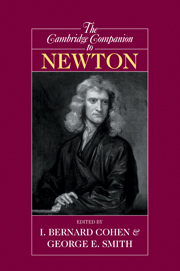Book contents
- Frontmatter
- Introduction
- 1 Newton's philosophical analysis of space and time
- 2 Newton's concepts of force and mass, with notes on the Laws of Motion
- 3 Curvature in Newton's dynamics
- 4 The methodology of the Principia
- 5 Newton's argument for universal gravitation
- 6 Newton and celestial mechanics
- 7 Newton's optics and atomism
- 8 Newton's metaphysics
- 9 Analysis and synthesis in Newton's mathematical work
- 10 Newton, active powers, and the mechanical philosophy
- 11 The background to Newton's chymistry
- 12 Newton's alchemy
- 13 Newton on prophecy and the Apocalypse
- 14 Newton and eighteenth-century Christianity
- 15 Newton versus Leibniz: from geometry to metaphysics
- 16 Newton and the Leibniz-Clarke correspondence
- Bibliography
- Index
9 - Analysis and synthesis in Newton's mathematical work
Published online by Cambridge University Press: 28 May 2006
- Frontmatter
- Introduction
- 1 Newton's philosophical analysis of space and time
- 2 Newton's concepts of force and mass, with notes on the Laws of Motion
- 3 Curvature in Newton's dynamics
- 4 The methodology of the Principia
- 5 Newton's argument for universal gravitation
- 6 Newton and celestial mechanics
- 7 Newton's optics and atomism
- 8 Newton's metaphysics
- 9 Analysis and synthesis in Newton's mathematical work
- 10 Newton, active powers, and the mechanical philosophy
- 11 The background to Newton's chymistry
- 12 Newton's alchemy
- 13 Newton on prophecy and the Apocalypse
- 14 Newton and eighteenth-century Christianity
- 15 Newton versus Leibniz: from geometry to metaphysics
- 16 Newton and the Leibniz-Clarke correspondence
- Bibliography
- Index
Summary
The opposition between analytical and synthetic proof methods has an intriguing and complex role in the history of Western mathematics. In Antiquity analytical method (in brief, analysis) was conceived of as a method of discovery, or problem solving: it starts from what is sought as if it had already been achieved, and, working step by step backwards, it eventually arrives at what is known. This and similar rather vague definitions were aimed at describing in a general way a whole apparatus of geometric problem solving procedures developed by the Greeks. Synthesis goes the other way round: it starts from what is known and, working through the consequences, it arrives at what is sought. The axiomatic and deductive structure of Euclid's Elements was the model of the synthetic method of proof. Analysis (or resolutio) was often thought of as a method of discovery preliminary to the synthesis (or compositio), which, reversing the steps of the analytical procedure, achieves the true scientific demonstration. Analysis was thus the working tool of the geometer, but it was with synthesis that one could demonstrate things in an indisputable way. In the Middle Ages this pattern of definitions became bound up with the philosophical and logical tradition. A question which was often raised concerned the relationship between the mathematical proof methods and other accepted forms of deductive proof, typically those codified in Aristotle's Organon.
- Type
- Chapter
- Information
- The Cambridge Companion to Newton , pp. 308 - 328Publisher: Cambridge University PressPrint publication year: 2002
- 12
- Cited by



